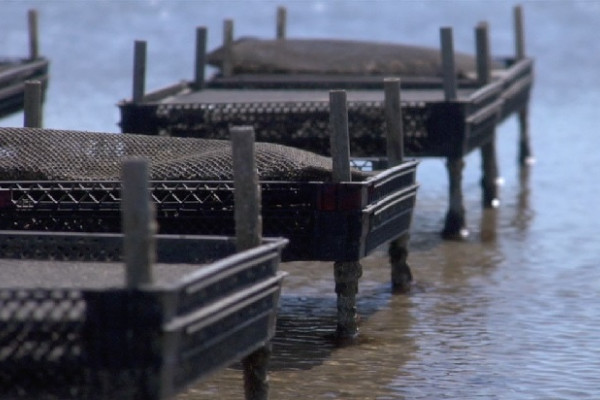
The state has a plan to fight back against ocean acidification.
Doreen Leggett
Ocean acidification has often been called climate change’s evil twin, and both global perils are so pervasive it can be hard to put them in perspective.
Seth Garfield found a way.
Many growers and towns on the Cape, and beyond, get the shellfish seed that drives their businesses and anchors their recreational harvest from A.R.C. Hatchery in Dennis, noted Garfield, president of the Massachusetts Aquaculture Association. If Cape Cod Bay waters that feed A.R.C. become more acidic, it can reduce or delay the growth of the seed that supplies hundreds of farms and dozens of towns.
“We depend on that hatchery,” Garfield said at an informational briefing last month when the state Commission on Ocean Acidification released an 84-page report that outlined the scale and threats, and provided ways to mitigate it.
Although the consequences of ocean acidification haven’t manifested themselves at ARC, they are on the horizon.
“We are running out of time before the consequences of ocean acidification become truly catastrophic,” said Rep. Dylan Fernandes, who is a member of the 20-person committee.
The world’s oceans have become more acidic and researchers point to two drivers: global increases in atmospheric carbon dioxide and local nutrient pollution leading to eutrophication of coastal waters.
In the mid-1700s, the concentration of atmospheric CO2 was approximately 280 parts per million (ppm). Today, the concentration of atmospheric CO2 is 411 ppm, a 47 percent increase.
The world’s oceans absorb as much as 30 percent of that carbon dioxide.
As the ph decreases so do carbonate ions needed to form shells, which spells trouble for shellfish such as oysters and sea scallops, and to a lesser, but still worrisome extent, lobsters. Research the report highlighted shows that ocean acidification can reduce mollusk survival rates by 34 percent and that surviving mollusks can be 17 percent smaller.
“While aquaculture may have the ability to postpone some of the preliminary OA effects by buffering hatchery water and planting larger, stronger shellfish seed, wild harvest shellfisheries reliant on wild seed do not have that luxury,” said Melissa Sanderson, chief operating officer of the Fishermen’s Alliance and the non-profit’s point person on shellfish. “That means it is imperative that we act quickly to dramatically reduce the nutrient pollution that is exacerbating local OA, before we start to see recruitment failures and economic impacts to the more than 1,400 commercial shellfishermen and farmers on the Cape and Islands.”
The report noted the U.S. shellfishing industry stands to lose $400 million annually by 2100 as a result of ocean acidification. Models show that if nothing changes the trends, by 2060 shells at the bottom of the Gulf of Maine will begin to dissolve.
Massachusetts is disproportionately affected by ocean acidification, study authors write, because the state’s success is so dependent on coastal economies.
There are other issues as well, Fernandes said. Massachusetts is a “hot” spot because the state is producing a high level of nutrient pollution coursing into the ocean, and it is dependent on waters said to be warming faster than any other in the world.
Regulations on the Cape, and beyond, have tried to reduce nutrient pollution, but efforts have fallen short. Nutrient pollution feeds into the problem, the report explained, because it causes excessive algae growth and when those plants die they release carbon dioxide.
Cape and Islands Senator Julian Cyr, who also served on the committee, enumerated ways the report aims to get ahead of the growing specter.
Creating a Blue Community Program modelled after the state’s Green Community Program, creating incentives for towns to address the problem, would be important, Cyr said, as would monitoring.
“With the right kind of monitoring we can predict hot spots,” Cyr added. That would help target investments.
Other recommendations in the report include: fund research into the economic and ecological effects of acidification, develop a set of best practices, update nutrient pollutant regulations, and create a permanent ocean acidification council.
The panel also talked about how other areas such as the Pacific, and Maine, are already facing problems with ocean acidification and some hatcheries are buffering the water used to grow their shellfish. Others are also growing kelp alongside shellfish for an added dose of mitigation.
“These changes are happening now,” said Kelly Kryc, the Director of Ocean Policy at the New England Aquarium, and a member of the committee.
Garfield agreed, saying that is why monitoring is key.
Garfield added that at his grant on Cuttyhunk Island, shells are fragile certain times of the year and it may be related to ocean acidification.
“The more information that is hooked to this wagon, we can make better decisions,” he said.
For Cyr the threat is generational as well. The emergence and success of aquaculture has made it possible for young people to afford to live on the Outer Cape and the islands.
“Aquaculture has been one of the bright spots,” Cyr said, which he does not want to see extinguished.
